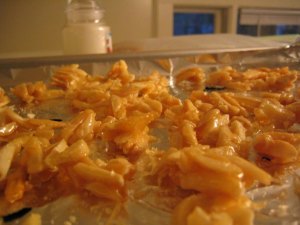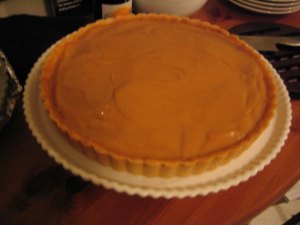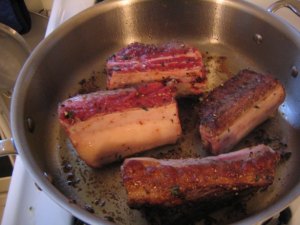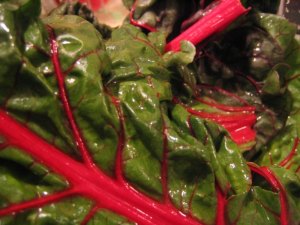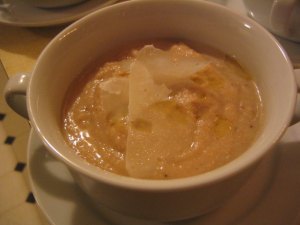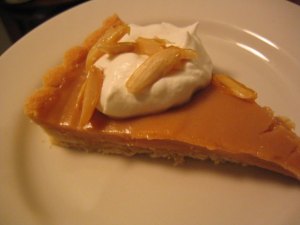Ok, in my past life (as a magazine writer in NYC) I got lots of cool stuff sent to me, since I covered design/lifestyle type issues. One of my favorite things was the pile of pre-publication proofs of books we were always getting, and I brought the best of the food-related ones with me to NH. The only one I’ve really used so far is Christopher Kimball’s The Kitchen Detective, from the editor/founder of Cook’s Illustrated. Right after we moved here I tried his Polenta Pound Cake recipe, and discovered the big flaw to using proofs of cookbooks: They haven’t gotten their final fact-check, and they’re missing stuff like page numbers, certain ingredient quantities, etc. I cooked so rarely in Brooklyn that I never noticed the gaping holes in these books! Anyway, the pound cake tipped me off, since it said to bake at 325, a very low temp for a cake like that, and it took over an hour and a half (instead of under an hour) to finally cook. Oops!
Well, non-baking recipes don’t require the same precision, and the other night I made Kimball’s “Four-Minute Chicken Cutlets” for the second time. Here’s the thing. They don’t cook in four minutes for me, because chicken seems to be my achilles heel, and I can’t get my head wrapped around preparing it. I feel stupid that I can cook pork and beef with no qualms but get all freaked out trying to get chicken ready to go… I had a really terrible time cleaning the boneless breasts and pounding them thin. I definitely didn’t get them super-thin like the recipe requires if you want them to cook in less than four minutes. I ended up on the phone with my mom, up to my elbows in chicken, completely freaking out because the breasts were tearing instead of pounding thin. Turns out I’m an idiot. Instead of slipping them in a ziplock or between saran wrap, I’d put them between PARCHMENT PAPER, meaning they couldn’t scoot around at all while I pounded them, meaning the poor things were shredded. Live and learn. I did salvage them, using my mom’s excellent advice to simply cut the breasts into smaller pieces so I could cook the thick and thin ends separately.
Anyway.
The wonderful thing about this recipe is the coating, which combines shredded parmesan with store-bought superfine breadcrumbs, to great effect. It’s a salty, flavorful, crispy coating, and makes chicken taste really savory and exciting instead of dull. Kimball’s recipe is really long (he does the CI thing and talks about how he tested all the elements of the recipe, etc.) but here’s my very short version:
For four chicken breasts (halves of big ones):
Season with salt and pepper
Dip the chicken breasts in egg white (he says 3 egg whites for this amount, I could have used two)
Dredge in 1/2 cup fine bread crumbs mixed with 3/4 cup grated parmesan
Heat 4 T olive oil until just smoking, cook the chicken 1.5-2 minutes on each side (he says to pound it to 1/4 inch. Mine was at least 1/2 inch and so took longer to cook).
Serve on a bed of arugula with sliced tomatoes over it, and some basil over the tomatoes if you want. I used cherry tomatoes, cut in half and dressed in sherry vinegar and olive oil/ salt/pepper, which added a nice juicy layer. (Cherry tomatoes tend to be pretty tasty even in the middle of winter.)
I over-roasted my new potatoes while trying to get all the chicken cooked…ah, well.
Before the chicken we had my third version of the cauliflower soup, this time made with Broccoflower! It’s a cross between broccoli and cauliflower (….obviously), and is an amazing shade of bright spring green, not quite captured by my photo:

I was hoping the soup would also end up bright green, but since the inside of the broccoflower is white, the soup was very pale green. I left the cheese out this time, and just sprinkled a little on top, which made it really light and nice, a perfect first course.

For dessert I made the Gateau Piège from Chocolate and Zucchini. Due to a slight clerical error in the original version of the recipe (it’s been fixed now) I underbaked it by quite a lot, so the middle was much denser and flatter than it should have been. I loved the flavor though, and it was super easy–I want to try it again this week, maybe with lemon this time.
Overall a very uplifting mid-winter meal, with lots of fresh flavors. I’ll try all of it again, hopefully with fewer bumps but a similarly tasty end product.



